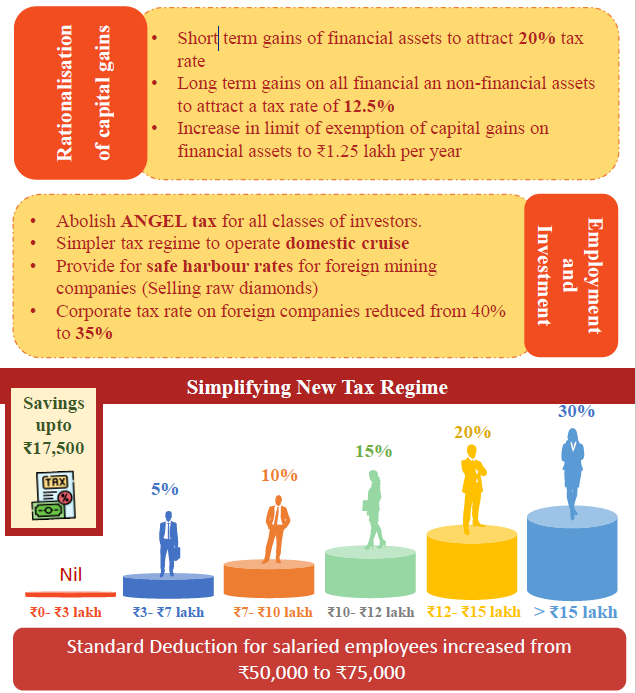Budget 2024-25 is released. Tax Slab in New Tax Regime is revised making it more lucrative for the taxpayers. Additionally, the standard deduction amount is increased to ₹ 75,000 from ₹ 50,000. Nirmala Sitharaman, the union finance minister, and her team have done a very good job and tried to make the common man happy. In the budget speech, 5 key income tax and direct tax changes are announced. These changes will directly affect the common man. Let’s take a look at 5 Key Changes Budget 2024-25.

Income Tax Slab and Direct Taxes – 5 Key Changes
#1 Income Tax Slab – New Tax Regime
The income Tax Slab for the new tax regime is simplified. As per the proposal, a 5 percent tax will be levied on income between ₹3-7 lakh, 10 percent between ₹7-10 lakh, 15 percent for ₹10-12 lakh. However, a 20 percent tax will continue to be levied on income between ₹12-15 lakh and 30 percent for income above ₹15 lakh. Earlier 5 percent tax was applicable on income up to ₹6 lakh. The new tax slab
New income tax regime tax slabs are:
Up to ₹ 3 lakh the tax is NIL
From ₹ 3 lakh to ₹ 7 lakh the tax rate is 5%
From ₹ 7 lakh to ₹ 10 lakh the tax rate is 10%
From ₹ 10 lakh to ₹ 12 lakh the tax rate is 15%
From ₹ 12 lakh to ₹ 15 lakh the tax rate is 20%
For above ₹ 15 lakh income the tax rate is 30%
The above rate rationalization leads to savings of ₹ 10000 for the highest tax bracket taxpayers.
#2 Standard Deduction
Standard Deduction for salaried employees increased from ₹50,000 to ₹75,000. The increase in the standard deduction of ₹25,000 leads to further tax savings of ₹7,500 for the highest tax bracket taxpayers. So, the total tax benefit of ₹ 17,500.
Further to the above, the standard deduction limit for family pensioners has been increased to Rs 25,000 from Rs 15,000. An increase in the standard deduction would mean more tax savings for salaried individuals and pensioners.
#3 Short-Term Capital Gain Tax
Short-Term Capital Gain (STCG) tax is applicable on selling equity investment before 12 months (1 Year). Short-Term Capital Gain Tax is increased to 20% from the current 15% rate. The other financial assets and non-financial assets shall continue to attract the applicable tax rate. The hike of 5% is likely to affect money inflow in the stock market slightly. This rise applies to the sale of all listed equity shares, equity-oriented mutual funds, and business trusts.

#4 Long-Term Capital Gain Tax
Any listed financial instruments held beyond 12 months (1 year) shall be considered as long-term. Long-Term Capital Gain Tax (LTCG) is revised. The revised LTCG rate is 12.5%. The earlier LTCG rate was 10%. This means any gains from stocks (equity) or equity-oriented mutual funds for a holding period above 1 year and above would be charged at 12.5%.
Long-term capital gains on all other long-term capital assets (section 112) have been reduced from 20 percent to 12.5 percent but indexation has been removed.
#5 Capital Gain Yearly Exemption Limit
Earlier Capital Gains up to ₹ 1 lakh per year were exempted from capital gain tax. Now, this limit is revised. As per Budget 2024-25, the limit for exemption on capital gains from certain financial assets has been increased to ₹1.25 lakh per year.

